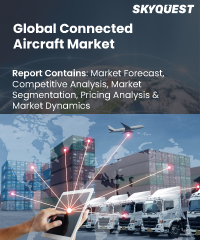
Report ID: SQMIG20A2151

Report ID:
SQMIG20A2151 |
Region:
Global |
Published Date: September, 2024
Pages:
202
|
Tables:
60 |
Figures:
75
In January 2024, All Nippon Airways (ANA) headed by Koji Oka, vice president of products and services innovations initiated its first connected aircraft flights and is now evaluating whether to proceed with a Ka-band or Ku-band solution. The Ka-band is appealing because it allows for service provision by a single company, while the Ku-band is noted for its potential to offer greater data capacity in the future.
In 2024, Honeywell is uniquely positioned to integrate its mechanical system equipment, maintenance, and diagnostics with its onboard avionics and data collection systems, extending this connectivity offboard in real-time. This capability effectively transforms the aircraft into a connected node in the sky.
In 2023, Boeing is considering the introduction of a satellite-based In-Flight Connectivity (IFC) system as an optional feature for its 737, 777, and 787 models. Implementing this type of connectivity directly from the production line would enable operators of the 787, which collects up to 146,000 data parameters per flight, to gather more comprehensive information about the aircraft's health during operation.
In 2023, the rapid advancements in AI technologies, particularly Large Language Models (LLMs), suggest that the industry will soon see significant implementations. Solutions like Aviadex.io are laying the groundwork for the adoption of these emerging technologies.
In May 2023, Honeywell Aerospace announced a partnership with Thales Group to develop advanced flight control systems for next-generation aircraft, focusing on enhancing safety, efficiency, and automation capabilities.
In March 2023, Viasat Inc. secured $175 million in funding from a syndicate of international lenders to support its ongoing investment in the development of its ViaSat-3 satellite constellation, expanding its global coverage and capacity.
In January 2023, Boeing announced a partnership with Xplore to explore the integration of Xplore's LEO satellite communication capabilities into Boeing's aircraft connectivity solutions, enabling faster and more reliable in-flight connectivity.
In September 2022, Collins Aerospace acquired FlightAware, a flight tracking and aviation data company, to enhance its capabilities in digital aviation solutions and offer improved flight tracking services.
In July 2022, Airbus and PAL Aerospace partnered to develop and market the Airbus Surface Maritime Awareness System (SMAS), a solution that combines satellite and aircraft surveillance data to enhance maritime surveillance capabilities.
Our industry expert will work with you to provide you with customized data in a short amount of time.
REQUEST FREE CUSTOMIZATIONWant to customize this report? This report can be personalized according to your needs. Our analysts and industry experts will work directly with you to understand your requirements and provide you with customized data in a short amount of time. We offer $1000 worth of FREE customization at the time of purchase.

Report ID: SQMIG20A2151